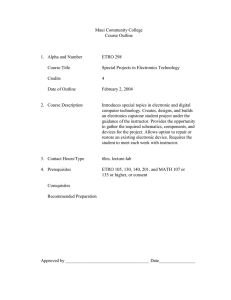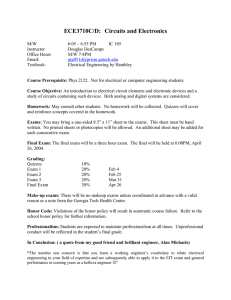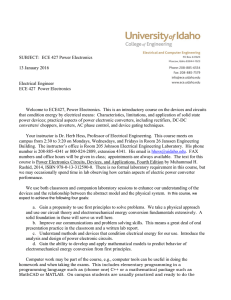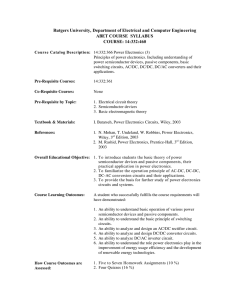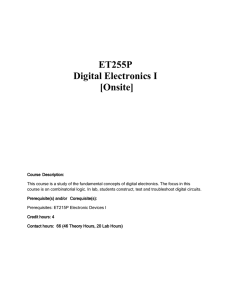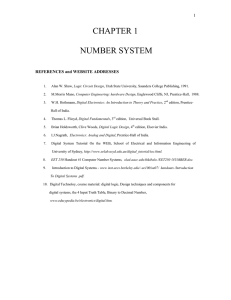Syllabus
advertisement
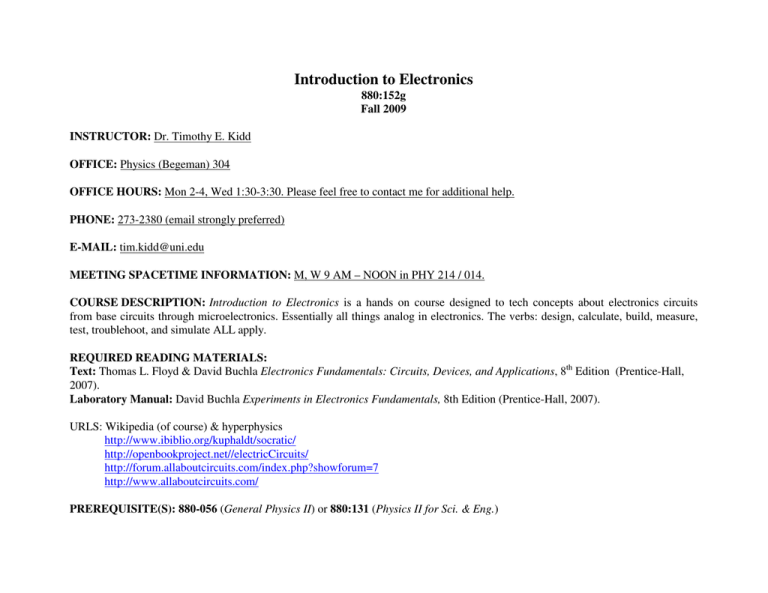
Introduction to Electronics 880:152g Fall 2009 INSTRUCTOR: Dr. Timothy E. Kidd OFFICE: Physics (Begeman) 304 OFFICE HOURS: Mon 2-4, Wed 1:30-3:30. Please feel free to contact me for additional help. PHONE: 273-2380 (email strongly preferred) E-MAIL: tim.kidd@uni.edu MEETING SPACETIME INFORMATION: M, W 9 AM – NOON in PHY 214 / 014. COURSE DESCRIPTION: Introduction to Electronics is a hands on course designed to tech concepts about electronics circuits from base circuits through microelectronics. Essentially all things analog in electronics. The verbs: design, calculate, build, measure, test, troublehoot, and simulate ALL apply. REQUIRED READING MATERIALS: Text: Thomas L. Floyd & David Buchla Electronics Fundamentals: Circuits, Devices, and Applications, 8th Edition (Prentice-Hall, 2007). Laboratory Manual: David Buchla Experiments in Electronics Fundamentals, 8th Edition (Prentice-Hall, 2007). URLS: Wikipedia (of course) & hyperphysics http://www.ibiblio.org/kuphaldt/socratic/ http://openbookproject.net//electricCircuits/ http://forum.allaboutcircuits.com/index.php?showforum=7 http://www.allaboutcircuits.com/ PREREQUISITE(S): 880-056 (General Physics II) or 880:131 (Physics II for Sci. & Eng.) SPECIAL NEEDS: The Americans with Disabilities Act of 1999 (ADA) provides protection from illegal discrimination for qualified individuals with disabilities. If you have any condition such as a physical or learning disability, which will prevent the fullest expression of your abilities or will require academic accommodations and would like to request instructional accommodation due to disabilities, you must arrange for such accommodation through the Office of Disability Services, 213 Student Services Center, Tel. 273-2676. GRADING: There will be three exams given during the semester and a final exam at the end of the semester. No credit will be given for answers without supporting work or reasoning in any assignment or exam. Exams will consist of a written portion and a laboratory practical. Homework: 15% (Lowest Dropped) Lab Reports: 15% (Lowest Dropped) Exams (3): 45% Final Exam: 25% Although any appropriate curve(s) will be announced in class, it is assumed that the following standard scale will be utilized. The grade cutoffs are as follows: 93% and above A, 90% A-, 87% B+, 83% B, 80% B-, 77% C+, 73% C, 70% C-, 67% D+, 63% D, 60% D-, below 60% F ATTENDANCE: Attendance is not formally taken but students are expected to attend and be active during class time. Advance warning of any class that will be missed should be given, especially for laboratory activities or exams. No late work will be accepted. LATE POLICY: Homework sets and lab reports are due on the dates indicated. Late work is not accepted with the exception of reasonable documented excuses. ACADEMIC DISHONESTY/PLAGIARISM: Collaboration on homework and lab reports is welcome, but please keep in mind that your final, turned-in work should be your own and not copied. However, no form of cheating/plagiarism will be tolerated in this class. INSTRUCTOR’S STATEMENT: The instructor reserves the right to modify this syllabus in a reasonable fashion and in the best interest of the class. LAB REPORTS: Lab reports should follow the outline given in the manual. HOMEWORK: Homework sets need not be typed but should be neat, stapled, and readable. Answers to conceptual questions should include all reasoning. Answers to quantitative problems should show all steps taken to get the answer. Answers to homework problems that are only a number or answer with no supporting reasoning will not be given credit.
